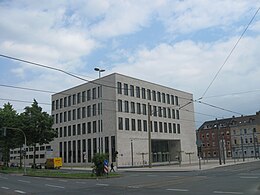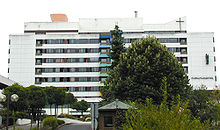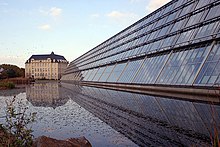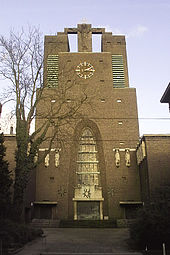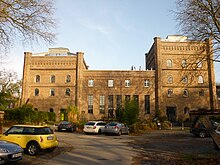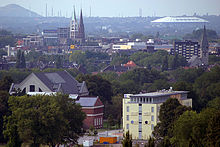Ückendorf
|
Ückendorf
City of Gelsenkirchen
Coordinates: 51 ° 29 ′ 36 ″ N , 7 ° 7 ′ 21 ″ E
|
|
|---|---|
| Height : | 58 m |
| Area : | 6.82 km² |
| Residents : | 20,208 (Dec. 31, 2018) |
| Population density : | 2,963 inhabitants / km² |
| Incorporation : | April 1, 1903 |
| Postal code : | 45886 |
| Area code : | 0209 |
|
Location of Ückendorf in Gelsenkirchen
|
|
|
View of the northern part of Bochumer Strasse
|
|
Ückendorf is a district of Gelsenkirchen in the Ruhr area . On December 31, 2018 there were 20,208 inhabitants in Ückendorf.
Geography and traffic
Ückendorf is located in the southeast of Gelsenkirchen on the city limits of Bochum-Wattenscheid and Herne -Wanne. In the north and west, Ückendorf borders the Gelsenkirchen districts of Bulmke-Hüllen, Neustadt and Rotthausen . In addition to the last two districts mentioned, Ückendorf is part of the Gelsenkirchen-Süd district . With an area of 6.821 km², Ückendorf is also the largest part of this city district.
The place is a very diverse district, which, in addition to many simpler residential areas with multi-family and colliery buildings, also has upscale residential areas with spacious single-family houses, such as the residential area east of Von-Wedelstaedt-Park.
Ückendorf has - presumably as a result of an oversight during a municipal territorial reform carried out in the 1920s - over approx. two hectare large exclave, which is located on the city limits between Bochum and Herne.
The most important traffic junction is the Ückendorfer Platz. The three most important traffic arteries meet here: On the one hand, Bochumer and Ückendorfer Strasse, which taper the district from north to south and from this point on as Ückendorfer Strasse to Bochum-Wattenscheid, and on the other hand, those to Bochum-Günnigfeld running Osterfeldstrasse.
Tram line 302 of the BOGESTRA runs on Bochumer Straße, which connects Bochum main train station with Gelsenkirchen main train station, the Veltins-Arena and the Gelsenkirchen district of Buer.
Ückendorf is connected to the federal motorway 40 , the Ruhrschnellweg, via the “Gelsenkirchen-Süd” junction .
history
The emergence of Ückendorf is closely linked to the settlement history of the old Germanic tribes, who also settled in the Bruchland on the Emscher between the fourth and seventh centuries. It is believed that the first Ückendorfer settlers called themselves "Huginge" or "Hukkinge" after their leader "Hugo" or "Hukko", from which the original name "Hugingsdorf" was derived. The vast majority of the courtyards and cottages belonged to the great manor of the Essen monastery. Ückendorf was first mentioned in a document around 1254 as the main courtyard of Essen Abbey .
The village structure of Ückendorf remained unchanged until modern times. The community consisted of a few farms whose names - such as Niermann, Schüffler, Schulte-im-Hofe, Dördelmann, Grollmann - can still be found in the street names of Ückendorf today. In 1486 there were 60 inhabitants living in Ückendorf, who were essentially spread over 14 farms; In 1855 there were 337 inhabitants. As a peasantry, Ückendorf belonged to the parish and later deanship Wattenscheid, which belonged to the Archdiocese of Cologne.
The rapid growth of Ückendorf only began at the end of the 19th century with mining in the Ruhr . With the start of coal production at the Holland colliery in 1856, the Rheinelbe colliery in 1861 and the Alma colliery in 1872, the population "exploded" forty-fold within 35 years (1855: 337 inhabitants; 1875: 5,275 inhabitants; 1890: 13,129 inhabitants). The appropriate infrastructure was built in Ückendorf in a short time. That included
- the Knappschaftskrankenhaus in the Knappschaftsstrasse, built in the Weser Renaissance style in 1905 - today only used for residential purposes - which initially had 200 beds,
- the miners' settlement Flöz Dickebank (its external structure is still largely unchanged and gives a good impression of the living conditions at that time),
- the Osterath – Dortmund Süd railway line of the Rheinische Eisenbahn-Gesellschaft via Bochum to Dortmund, which was put into operation in 1874 (a relic from this time is the Gelsenkirchen-Wattenscheid station, which is now exactly on the city limits of Bochum and Gelsenkirchen),
- the Almaschule on today's Hohenfriedberger Strasse (1883), the park school on Parkstrasse (1899), the Rheinelbeschule on today's Carl-Mostert-Strasse,
- the power station (which was still recognizable in some structural remains on the factory premises of W. Geldbach until 2004),
- the slaughterhouse on Ückendorfer Straße and Dördelmannshof, which was closed in 1906,
- the Catholic Church of St. Josef, the cornerstone of which was laid on November 11, 1894 at the corner of Ückendorfer Straße and Südstraße (today Virchowstraße) (the parish of St. Josef grew into the largest parish in Germany in the 1920s),
- the Protestant Nicolaikirche, which was inaugurated on March 15, 1894 at the corner of Ückendorfer Strasse and Nordstrasse (today Flöz Sonnenschein).
Due to its size, Ückendorf became its own office in the Gelsenkirchen district in 1876, thus breaking away from the Wattenscheid office. The first bailiff was Hermann Schaefer , he was followed in 1879 by Adalbert Cramer (who is still remembered today by the name of the street Cramerweg). The first office building was on Ziegelstrasse; later a new office building was built on Knappschaftsstraße (corner of Bochumer Straße) and the first office building was rededicated as a poor house.
On April 1, 1903, Ückendorf (former spelling of the community: Ueckendorf) became part of the newly emerging city of Gelsenkirchen and thus lost its independence. At that time the community had 21,937 inhabitants. The last bailiff in office from April 1, 1896, Carl von Wedelstaedt , was Gelsenkirchen's first mayor from 1919 to 1928.
In 1935, the sociologist Wilhelm Brepohl founded the research center for folklore in the Ruhr area , which was initially located in Brepohl's apartment and then in the administration building of the Glück-Auf brewery in Ückendorf.
During the Second World War , Ückendorf was one of the most bombed districts of Gelsenkirchen , along with Scholven . On January 17, 1945 alone, 46 high-explosive bombs , two air mines , 2,300 incendiary bombs and 250 phosphorus incendiary bombs fell in a heavy air raid on Ückendorf . The liberation from the National Socialist regime took place at the beginning of April 1945 by American troops, who last fought an urban battle with the Volkssturm and the Sauerland Freikorps - equipped with bazookas, historical weapons, scythes and flails in the Ückendorfer Strasse . After this last resistance had been put down, the US troops - greeted by many surviving Ückendorf residents to whom the Americans distributed cigarettes - entered the district in Sherman tanks across Bochumer Strasse.
population
As of December 31, 2019, there were 20,187 residents in Ückendorf.
- Share of the female population: 50.0% (Gelsenkirchen average: 50.4%)
- Share of the male population: 50.0% (Gelsenkirchen average: 49.6%)
- Proportion of foreigners: 25.4% (Gelsenkirchen average: 21.7%)
Urban development
Ückendorfer Platz
The Ückendorfer Platz forms the historical center of Ückendorf. It developed from the Burbrink, the original village square of the community. The square was surrounded by linden trees (which is still reminiscent of the name of the nearby street "Im Lindacker") and had a village pond ("Amtsteich") fed by a natural spring, which was drained in 1898 as part of the track renovation for tram line 2 . On the square was the "Lindenstein", a boulder which owes its name to its location under the village linden tree. The linden stone marked the meeting place of the village farmers and was also the place of execution of the lowest jurisdiction, where justice was still pronounced well into the 18th century. When a traffic junction developed at Ückendorfer Platz, the Lindenstein initially found a new place at the Amtshaus in Ziegelstraße; today it is at the main entrance of Von-Wedelstaedt-Park. According to legend, the linden stone was thrown onto the Ückendorfer village square by a giant living on the Tippelsberg (in today's Bochum-Riemke) in a dispute with the giant living on the Mechtenberg (in today's Essen-Kray). The Lindenstein was so well known at the time that its very existence was cited as evidence of the truth of this legend.
“One piece from the two risengripers from the Tieppelsbiarg and from the Mechtenbiarg.
Git wieten all, dat frööer op den Mechtenbiarg en rise wuonde un enen op de Tieppelsbiarg. The Tieppelsbiarg liet and stünken van Baukem and the Mechtenbiar liet liet wiages van Watsche na Allenessen.
The two risen bokken and tehoupe broud. Once you want to bake one, then the other broud un so gonk et ümmer üm. Now you want to bake it de kedel op den Mechtenbiarg broud, and de vam Tieppelsbiarge may make your cracks. When nu de rise op den Mechtenbiarg in the truag, then it was tid, dat de vam Tieppelsbiarge sin broud broke. Dat schrappen i de truag ludden uw who has as when he thundered. - As nu de stunne da what, where the rise of eighth Baukem may come, sik de op de Leithe faquanz scrape at the Rüggenstrank un depper darunner. Dat could awwer the op den Tieppelsbiarg hear, and he came ok right un brach de broude. Awwer da had in de Leithe after no other offer, and de van Baukem came fröü. There wor he so bad, that one stone nam and one risen smeit. Dä leip awwer wech un arrived in Ueckentüarp in a few jumps. Since fol ok de stein terdale, un he liet after di dat spreitenhüsken. The groute stone kent alle lüe, de in de giegend, un he het nich other than de groute kieseling van de kedel op den Tieppelsbiarg. "
Say about the two giants on the Tippelsberg and on the Mechtenberg.
Ückendorfer Strasse
From a historical point of view, it is not Bochumer Strasse, but Ückendorfer Strasse that actually forms the main street in Ückendorf. It connected the Hellweg in Wattenscheid with the Lippe-Hellweg and crossed the village center of Ückendorf, today's Ückendorfer Platz. After the first Ückendorfer school was built on the corner of the Festweg, the street was given a name for the first time and was called "Schulstraße". Ückendorfer Strasse only got its current name with the incorporation of Ückendorf into Gelsenkirchen. Also the tram line 2, today's line 302 of the BOGESTRA, did not run over the Bochumer, but over the Ückendorfer Straße, and initially only on a single track. Tram traffic on Ückendorfer Straße was stopped in 1955.
Bochumer Strasse
Today's Bochumer Straße was originally just a small dirt road that turned off the Ückendorfer Straße at the village square. However, there were plans early on to set up the “upper-class district” of Ückendorf along this path. The paved road was therefore laid out as an avenue at its southern end, starting at Ückendorfer Platz with a width that is still remarkable today, which earned the street the name "Chaussee" in popular parlance at the time. Bochumer Strasse was the first street in Ückendorf to receive sewers and lighting. The upper middle class character of this southern quarter can still be seen today in the facade design of the houses that were built on Bochumer Straße between Ückendorfer Platz and Virchowstraße and on Parkstraße opposite Von-Wedelstaedt-Park. This is where the - in many cases preserved - director's villas of the large companies based in Ückendorf were located, the local savings bank and also the second office building, which was built in 1880/1881 on the corner of Bochumer and (today's) Knappschaftsstraße and in which not only the service rooms, but The private apartment of the Ückendorfer bailiff was also housed (demolished around 1955 and replaced by the new police station). At the confluence with Markgrafenstrasse stood the “Hotel Brüggemann” (built in 1899), of which only the restaurant (“Zum Südpark”) is preserved today. The single-track Kray-Wanner-Bahn (route 2209) crossed between Markgrafenstrasse and the police station west of house No. 223 , which has since been abandoned and converted into a bicycle and footpath. The villa located between the aforementioned railway line and the police station and the kiosk on the street were demolished and replaced by several residential buildings.
In its northern part, starting at the intersection with today's Virchowstraße, Bochumer Straße has always been a shopping street, in which almost every house on the ground floor has a shop or a restaurant. A revitalization of this section of Bochumer Straße is expected from the construction of the Gelsenkirchen judicial center at the intersection with Junkerweg. Tram line 302 runs through it along its entire length .
Economical meaning
For a long time, the economic development of Ückendorf was dependent on the development of local mining. After Gelsenkirchener Bergwerks-AG (GBAG) took over the previously independent mining law unions Alma and Rheinelbe in 1878 , the company soon developed into the most important company in Ückendorf. The GBAG was based on the site of the Rheinelbe colliery and was under the formative influence of Emil Kirdorf after he joined the company . Under his leadership, GBAG became the largest coal mining company in Europe. By taking over the Hansa , Zollern and Germania collieries , Kirdorf expanded GBAG, incorporated the "Schalker Mine and Huts Association" founded by Friedrich Grillo into it in 1904 and built GBAG into a vertically integrated company by taking over coal trading, pipe manufacturing and shipping companies Conglomerate, which formed the nucleus of the later Veba-Gelsenberg group. Due to the unique importance that mining had for the community at that time, Kirdorf was probably not wrongly viewed as the “real ruler” of Ückendorf at that time.
With the crisis in the Ruhr mining industry in the 1960s, the subsequent industries based in Ückendorf also got into difficult waters.
The district received a new upswing with the construction of the new Marienhospital Gelsenkirchen in 1970, which has since become the academic teaching hospital of the University of Duisburg-Essen . In 1976 the University of Applied Sciences for Public Administration in North Rhine-Westphalia and the school center on Bochumer Straße followed. The Ückendorf comprehensive school was opened in 1982 as the second comprehensive school in Gelsenkirchen and replaced the three types of school that had previously been located in the Ückendorf school center.
The Glückauf-Brauerei AG was brewing until its integration into the group of Brau und Brunnen AG in 1980 at the Leithestraße. The company emerged in 1895 from the “Glückauf” brewery, Fritz Schulte im Hofe, Pokorny & Co. and, with a production capacity of 180,000 hectoliters, was one of the largest breweries in the area at the time. In 1928 the Glückauf Brauerei AG founded an interest group with the Dortmund Ritter Brewery , which remained its largest shareholder for decades. A domination agreement was concluded with the Schultheiss brewery in 1971. The brewery restaurant, the "Glückaufkeller", is still located on Leithestrasse today. The building was designed by the architect Josef Franke .
The former machine hall and later wages hall of the Rheinelbe colliery was converted in 1993 into the “lichthof” conference hotel.
The Gelsenkirchen Science Park was established in 1995 on the site of the former Gelsenkirchener Gußstahl- und Eisenwerke AG , one of the most striking symbols of structural change not only in Ückendorf but all of Gelsenkirchen. The building erected as part of the International Building Exhibition Emscher Park now houses service and research companies in the fields of (solar) energy, information and communication technology and health. The Science Park also houses the Institute for Work and Technology of the State of North Rhine-Westphalia and the municipal departments for urban development and economic development. The 300 meter long glass arcade is also used for exhibitions and receptions.
The IKT - Institute for Underground Infrastructure , which deals with the development of innovative sewer systems, has been located in Exterbruch since 1994 .
The Gelsenkirchen labor court has been based in the former administration building of Gelsenkirchener Gußstahl- und Eisenwerke AG since 1995.
education
The North Rhine-Westphalia University of Applied Sciences for Public Administration (with departments in Duisburg, Cologne and Münster) has its headquarters in Ückendorf. Students are civil servants who strive for higher service.
The Marienhospital is an academic teaching hospital of the University of Duisburg-Essen.
art
Halfmannshof artists' settlement
On April 1, 1926, the Halfmannshof became the property of the city of Gelsenkirchen. In autumn 1931 the city of Gelsenkirchen began to build up the farm acquired from the farmer Halfmann as an artist settlement Halfmannshof . The idea for this came from the then welfare department of the city of Gelsenkirchen, Friedrich Wendenburg. Reference is made to the idea, already known from the Weimar Bauhaus , of uniting several artists under one roof. In the 1960s and 1970s, the Halfmannshof artists' settlement was a nationally important center for the visual arts. The trigger was the discovery of foam as an art design material by the Halfmannshof spokesman at the time, Ferdinand Spindel. It lured art experts from Düsseldorf and Cologne to Ückendorf; the Halfmannshof developed into a center of the avant-garde. “Der Hof” organized important exhibitions, in particular with works by the ZERO group .
Gallery stone
The studio and gallery of the wood cutter and poet Heinz Stein , who dedicated his work to contemporary graphics, is located on Bergmannstrasse .
Galerie Hundert - Pixel Project Ruhr Area
Galerie Hundert is also located on Bergmannstrasse. Photographs from the collection of the pixel project Ruhrgebiet are exhibited and sold there . The name of the gallery is derived from the fact that the photographs are each produced in a limited edition of 100 + 1 pieces.
image.languages
In 2009 bild.sprach moved into its project office on Bergmannstrasse. The focus of the work is the platform of the same name for photography and photography projects. Until 2013, the project carried out various photo exhibitions related to the district, installed the digital district newspaper and in 2014 carried out various photo projects with national and international photographers.
Rheinelbe art station
Marion and Bernd Mauß's studios are located on the site of the former Rheinelbe colliery.
Gelsenkirchen gallery mile
In 2010, on the initiative of Peter Liedtke, several galleries and studios merged to form the Gelsenkirchen gallery mile. In 2013, this resulted in the Ückendorf creative quarter.
architecture
Catholic parish church "Holy Cross"
From an architectural point of view, the district is a magnet for foreign visitors , especially because of its former Catholic parish church Heilig-Kreuz, designed by Josef Franke and located on Bochumer Straße . The church, built between 1927 and 1929, is one of the main German works of brick expressionism . Its west side is dominated by the 41 meter high main tower, which has three portals and a large window in the form of a parabola. The main tower braces the two bell towers, which are connected by a mighty brick crucifix that goes back to a design by the Gelsenkirchen sculptor Hans Meyer, it depicts the crucified Christ with a crown on his head. On the east side the nave ends in another Tower which, due to its design, is reminiscent of the Malakow towers used in the early days of Ruhr mining. The interior is formed by a 19-meter-high and 17-meter-wide hyperbolic barrel made of reinforced concrete. The sacred space is also particularly characterized by its wonderful acoustics .
Science Park Gelsenkirchen
The Gelsenkirchen Science Park , which was awarded the German Architecture Prize and was designed by the Munich architect Uwe Kiessler, was built just a few meters from Franke's "Heilig Kreuz" parish church . The building has an approximately 300 m long glass arcade that opens onto a newly created park and pond landscape on the site of the “cast steel mill” founded by Wilhelm Munscheid . The connected office wings are at right angles to the rear wall. After dark, the glass facade is illuminated by an installation by the light artist Dan Flavin . When it was built in 1996, the world's largest rooftop solar power plant was installed on the roof of the building, which covers around a third of its electricity needs.
Twin Malakow Tower, Colliery Holland, shaft 1/2
Pit 1/2 of the Holland colliery is located on Ückendorfer Strasse just before the city limits of Bochum-Wattenscheid . It is the only mine in the Ruhr area that has been preserved with a twin malakow tower . Built in the years 1860 and 1870, both towers today form an impressive testimony to the beginnings of the Ruhr mining industry, which were clearly shaped by the know-how of foreign investors. The latter is also reflected in the architecture of the two towers, which has echoes of English Tudor Gothic. The middle section connecting the towers today dates from the 1920s.
In 2006, apartments and offices were set up inside the two listed Malakow towers and the central section connecting them. The former boiler house - supplemented by an extension made of concrete, glass and steel - now houses a restaurant.
The architect Josef Franke took up the motif of the Malakow towers in the design of the parish church "Heilig Kreuz" by creating unmistakable references to the smaller tower on the east side of the church, not least in the proportions and in the facade.
Administration building Alma coking plant, fan building Zeche Holland shaft 1/2
It is hardly known that there are also two buildings built by Fritz Schupp and Martin Kremmer in Ückendorf . Schupp and Kremmer, who achieved fame as the architects of the Zollverein colliery, which is now on the UNESCO list of world cultural heritage , also designed the Alma central coking plant, which went into operation in 1928 . Above all, it supplied the blast furnaces of the Schalker Verein to the north with coke by means of a cable car over the tracks of the former Cologne-Minden Railway . The coking plant was demolished in the 1960s - with the exception of the administration and masticatory building, which can still be seen from Almastraße today. The building consists of a two-storey middle section, which is flanked by two single-storey wing structures. The facade is characterized in the manner typical for the buildings of Expressionism by encircling concrete cornices and decorative brick strips. Although the building is widely considered a monument, it is in danger of decay.
Schupp and Kremmer also designed the ventilator building from 1925, which has been preserved on shaft 1/2 of the Holland colliery .
Catholic parish church “St. Thomas More "
The Roman Catholic parish church “St. Thomas More ”was built in 1966 and was designed by the architect Gottfried Böhm , who is known for his sophisticated sacred buildings . The brick-built building ensemble - it also contains a rectory, parish and youth home as well as a kindergarten - is shaped in its design by the protrusions and recesses typical of Böhm; However, these are - unlike, for example, in Böhm's famous Neviges pilgrimage cathedral - executed at right angles in this building. The sloping roof, which covers all structures with the exception of the tower, is decisive for the appearance.
Wilhelminian style architecture in the district south of Bochumer Strasse - Markgrafenstrasse - Parkstrasse - Niermannsweg
A good impression of the economic strength of the industrialization that took hold in the community at the beginning of the 20th century is still conveyed today by the largely preserved historicist buildings in the quarter south of Bochumer Strasse - Markgrafenstrasse - Parkstrasse - Niermannsweg. Most of the mostly free-standing, villa-like buildings were built by local companies for their executives, who lived here with their staff on partly park-like properties. One of the two villas built by the “waterworks for the northern Westphalian coal district” (today's Gelsenwasser AG) has been carefully restored in the meantime , and their designs were placed in Parkstrasse as the only houses on the side of the street facing Von-Wedelstaedt-Park by the architect Josef Franke.
Halde Rheinelbe with "Himmelstreppe"
Although the Rheinelbe colliery stopped mining in 1928, the mine dump on its site was used until the late 1990s to store rock remnants ("mountains") that were inevitably extracted during coal extraction. Insofar as such “mountains” were later not used again as building materials, today they form the heaps that can be found everywhere in the Ruhr area, which have meanwhile largely been “recaptured” by nature. One of the sehenswertesten tailings areas of the district is at the former Kray Wanner train , now Emscher Park cycle track , located stockpile Rheinelbe that last more heaped and at the International Building Exhibition Emscher Park in 1999 by the artist Herman Prigann was redesigned. Above all, the “heavenly staircase” installed by Prigann has achieved national fame.
theatre
On August 12, 1883, Karl Höfert founded the Preziosa theater company in Ückendorf , which today has its venue in the auditorium of the comprehensive school on Bochumer Straße. While singing, comedy and drama were originally staged, today tabloid comedies and fairy tales dominate the program.
movie theater
Until the late 1970s there were four movie theaters in Ückendorf, namely
- the "Rex" located in Lindacker (still recognizable today in the rear part of the "Haus Siebrecht" restaurant),
- the "Roland Kino" on Bochumer Strasse (now a supermarket)
- the “Scala” on Regensburger Strasse and
- the "Odeon", Ückendorfer Str. 40
Even today, films are shown in the auditorium (mentioned in the theater section) as part of the “communal cinema”.
Green spaces
Von-Wedelstaedt-Park
Von-Wedelstaedt-Park (sometimes also called Südpark) is of particular interest in terms of garden architecture. It has an area of about nine hectares and has an artificially created pond with a fountain. In contrast to the gardener's house in the Swiss half-timbered style, the originally built animal enclosures - in which u. a. the Caucasian brown bear "Philipp" stayed - no longer available today. The name of the park on Parkstrasse goes back to Carl von Wedelstaedt , the last bailiff of the independent office in Ückendorf. Von Wedelstaedt had the park built in 1899/1900.
Rheinelbepark
The origin of the Rheinelbepark goes back on the one hand to the garden of Emil Kirdorf's villa, which no longer exists today, and on the other hand to a highly fenced private park built by Gelsenkirchener Bergwerks AG exclusively for its executives, the size of which even allowed the members of the mine to use Pursue the hunt. The city of Gelsenkirchen acquired this site in 1959 and made it accessible to all citizens. The park is characterized by its very old trees; there are beeches that are around 180 years old, for example. The 'Sachsenwaldeiche' is also preserved in the park. It was planted on April 10, 1896 as a gift from Otto von Bismarck to Emil Kirdorf. The tree is approx. 12 m high and has a trunk circumference of 180 cm.
"Old graveyard"; Südfriedhof
The remains of the "Old Cemetery" are a small park on Elsa-Brandström-Str. preserved. Originally, it was of great importance to the Ückendorf population, because after its installation in 1892 it was no longer necessary to bury the deceased in Wattenscheid. The building of today's Spunk cultural center on Festweg served as the mourning hall of the “Old Cemetery”. Although the city of Gelsenkirchen converted the cemetery into today's park in 1961, its roots remained recognizable for a long time through some gravestones that remained in the bush.
In view of the rapid population growth, the “Old Cemetery” soon became too small. As early as 1900, the second Ückendorfer cemetery, today's "Südfriedhof", was created on Osterfeldstrasse (today Günnigfelder Strasse). The grave of Kurt Neuwald , one of the co-founders of the Central Council of Jews in Germany and an honorary citizen of the city of Gelsenkirchen, is now located on its Jewish part .
Pestalozzihain
The Pestalozzihain is located between the two main churches of Ückendorf, the Catholic St. Josef Church and the Protestant Nicolaikirche. This small park has recently achieved particular identity-creating importance for the people of Ückendorf, as the local clubs and organizations hold a Christmas market there every year on the second Sunday in Advent.
360 ° panorama
Sports
Sports facilities
The largest sports facility in Ückendorf is the south stadium, which can hold around 21,000 spectators and in which SG Eintracht Gelsenkirchen e. V. (second division soccer team in the years 1950–1952, 55–63, 64–69, 70–73) carries out its home games. The main square has a running track as well as a covered main stand with seating.
As sports facilities are also u. a. the sports facilities on the premises of the comprehensive school, several tennis courts and an indoor soccer facility are available.
Car races were held in the Motodrom Gelsenkirchen , which was located on the site of the former Alma coking plant, until the late 1980s .
sports clubs
Soccer
The most famous football clubs in Ückendorf include Kickers Ückendorf, SG Eintracht Gelsenkirchen, DJK Schwarz Weiß Gelsenkirchen-Süd and Arminia Ückendorf.
tennis
There are two tennis facilities in Ückendorf, which are run by the Rheinelbe e. V. and the and the TC Ückendorf e. V. be entertained.
Shooting sports
The Gelsenkirchener Schützengilde, located in Ückendorf, maintains not only traditional customs but also shooting sports.
Personalities
- Rudolf Schulte im Hofe , painter and member of the Berlin Academy of the Arts, was born on January 9, 1865 in Ückendorf.
- Otto Boyer , painter and writer, was born on June 21, 1874 in Ückendorf.
- Emil Kirdorf , industrialist, shaped the economic development of the district for a long time as general director of the Gelsenkirchener Bergwerks AG based in Ückendorf - the nucleus of the later Veba-Gelsenberg group. He later lived in Mülheim an der Ruhr. Hitler had his death staged for propaganda purposes in Ückendorf by ordering a state funeral and through his personal presence.
- Josef Franke , architect, not only built some preserved, listed buildings in this district, but also lived and worked here from 1905 to 1909, since 1906 in his own house at Markgrafenstrasse 3 / 3a.
- Carl Hundhausen , public relations specialist, was born on November 1st, 1898 in Ückendorf.
- Klaus-Peter Wolf , writer and screenwriter, grew up in Ückendorf.
- Robert Paetz, ODEON-Kino Ückendorferstr. 40, founder of Westdeutsche Schulfilm 1949, first nationwide film media project for schools, publisher of the magazine Film-Jugend-Schule , owner of the Studio Filmverleih , winner of the City of Gelsenkirchen Prize for Culture.
- Ludger Volmer , founding member and from 1991 to 1994 federal chairman of the party Die Grünen and from 1998 to 2002 Minister of State in the Foreign Office, grew up in Ückendorf.
- Reinhard Klenke , District President, lives in Ückendorf.
- Michael Skibbe , soccer coach, was born in Ückendorf and grew up there.
- Norbert Elgert , coach of the A-youth team and former professional player of FC Schalke 04 , grew up in Ückendorf
- Markus Kauczinski , soccer coach of 1. FC St. Pauli, grew up in Ückendorf.
- Hans-Jürgen Gede , soccer coach (including the Uzbek national team until 2005) and former soccer player ( FC Schalke 04 ) was born on November 14, 1956 in Ückendorf.
- Walter Trockel jun. , Professor (1984–2012) and Director (2002–2009) at the Institute for Mathematical Economic Research (IMW) at Bielefeld University, attended the park school from 1950 to 1954 and grew up in Ückendorf.
- Norbert Dörmann , former soccer player a. a. for FC Schalke 04 and Borussia Dortmund , played a total of 60 Bundesliga games
- Friedrich Kronenberg , politician, member of the German Bundestag, General Secretary of the Central Committee of German Catholics
Selected Ückendorfer street names and their meaning
- Almastrasse - commemorates the Battle of the Alma (September 20, 1854) in the Crimean War between Russia on the one hand and France and Great Britain on the other.
- Am Dördelmannshof - reminiscent of the Dördelmann family homestead.
- Carl-Mosterts-Straße - named after the Catholic youth chaplain Carl Mosterts , who founded the DJK . The street has an eventful past in terms of its name: It was originally called Sedanstraße, from 1903 Yorkstraße and from 1946 Göttinger Straße. It has had its current name since 1969.
- Festweg - The connection between today's Ückendorfer Straße and the original communal festival meadow, which was located roughly at the location of today's Schulte-im Hofe-Platz, was formed in the 19th century by a small dirt road, for which the today's name Festweg naturalized.
- Grollmannstraße - Reminiscent of the old Ückendorfer family Grollmann.
- Görresstraße - name in honor of the Catholic publicist Joseph Görres . The choice of name is related to the development of the entire street by the Catholic "Eigenhaus - Gemeinnützige Bau-Spargenossenschaft" from 1928.
- Hohenfriedberger Straße - Reminiscent of the Battle of Hohenfriedberg in the Second Silesian War (see also Spichernstraße).
- Im Lindacker - reminiscence of the linden trees that surrounded the original village square - today's Ückendorfer Platz.
- Im Rosenhag - Originally this street - also built by the Catholic "Eigenhaus - Gemeinnützige Bau-Spargenossenschaft" from 1928 - was to be called "Maria im Rosenhag", which refers to famous depictions of the Virgin Mary (see, for example, Lochner's Madonna in the Rosenhag ) would have. Because of the National Socialist seizure of power, this planning had become practically impossible when the development was completed.
- Niermannsweg - Reminiscent of the old Ückendorfer family Niermann.
- Schulte-im-Hofe-Platz - In memory of the Ückendorf-born painter Rudolf Schulte im Hofe
- Spichernstrasse - Remembers the place Spicheren , which - like the city of Weißenburg - was the scene of a famous battle in the Franco-German War of 1870/1871 (see also Battle of Spichern and Battle of Weissenburg ).
- Weißenburger Strasse - See Spichernstrasse.
literature
- Gelsenkirchen in old and new times . A home book. Published by the Heimatbund Gelsenkirchen, Volume I, born in 1948, Ückendorf district
Web links
Individual evidence
- ↑ Population structure in Gelsenkirchen as of December 31, 2018 - data source: City of Gelsenkirchen - opendata.gelsenkirchen.de
- ↑ Stephanie Reekers: The regional development of the districts and communities of Westphalia 1817-1967 . Aschendorff, Münster Westfalen 1977, ISBN 3-402-05875-8 , p. 287 .
- ^ Johannes Weyer : The research center for the people in the Ruhr area (1935-1941). An example of sociology in fascism. In: Soziale Welt , 35: 1984, p. 128 PDF ( Memento from June 29, 2015 in the Internet Archive )
- ↑ Population structure in Gelsenkirchen as of December 31, 2019 - data source: City of Gelsenkirchen - opendata.gelsenkirchen.de
- ↑ Population structure in Gelsenkirchen as of December 31, 2019 - data source: City of Gelsenkirchen - opendata.gelsenkirchen.de
- ↑ Population structure in Gelsenkirchen as of December 31, 2019 - data source: City of Gelsenkirchen - opendata.gelsenkirchen.de
- ↑ Share of foreigners in Gelsenkirchen as of December 31, 2019 - Data source: City of Gelsenkirchen - opendata.gelsenkirchen.de
- ↑ a b Heimatbund Gelsenkirchen (ed.): Gelsenkirchen in old and new times. A home book . Volume 1: History of Gelsenkirchen . Post, Gelsenkirchen-Buer 1948, p. 100.




